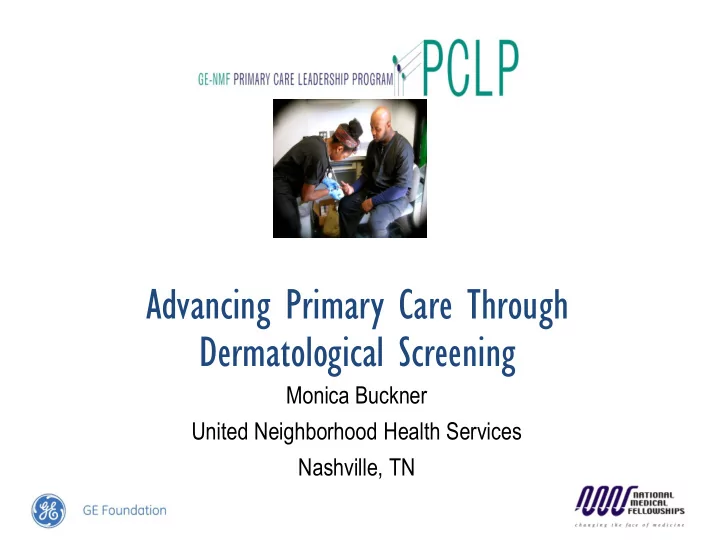

Advancing Primary Care Through Dermatological Screening Monica Buckner United Neighborhood Health Services Nashville, TN
Introduction • Diabetes Mellitus Type 2 increases healthcare delivery costs, while negatively impacting patient quality of life. • healthcare system can benefit from effective screening with the addition of counseling with evidenced based recommendations during outpatient visits. • To investigate this belief I created a study focusing on the presence of Acanthosis Nigricans (AN) in relation to finger stick glucose testing to identify those at risk for Diabetes Type 2. • I sought to combine my dermatological career interests with primary care screening techniques to increase the overall well being of patients • Personal investment in distribution of healthcare to the underserved. • Underserved communities undertake environmental and social issues such that their health becomes of low priority.
Background • 8.3% of the population has diabetes, 12. 6% are non-Hispanic blacks and 11.8% Hispanic. • High-risk ethic groups are population base of community health centers • Elevated blood glucose can damage eyes, kidney, skin, nerves, and blood vessels • Unfortunately, patients who experience symptoms of organ damage and are not aware of it . • Prevention is key to decreasing morbidity, mortality, and increased health care cost.
Methodology • Location: United Neighborhood Health Care Services Community Health-Care events • Introduction of the improvement quality control consent forms • Participants received a numerical value with a Diabetes fact sheet with current UPSTF recommendations • General ten minute physical exam with focus on Acanthosis Nigricans + finger stick glucose test
Methodology • Participants informed of their results, indications of risk reduction, and referral letters for diabetic blood glucose levels • sample size was isolated based on elevated blood glucose levels. • Then, the sample was evaluated for how many participants had Acanthosis Nigricans and the corresponding average blood glucose level.
Results Blood Glucose Distribution of 20% were found to have Blood Sample Size glucose levels qualifying them as Type 2 Diabetic 44% (11/25) of participants were found to have elevated >126 mg/dL Fasting blood glucose 100-125mg/dL qualifying them as pre-diabetic <100 mg/dL 36% of participants were found to have normal fasting blood glucose levels .
Results • 11/25 Participants found to have Acanthosis Nigricans on physical exam. • Presence of AN Average blood glucose of 124.82 mg/dL • AN not present average blood glucose of 105.43 mg/dL. Presence of AN in Sample Size AN No AN
Discussion • Findings support high rate of diagnosed diabetics in the United States • Demonstrates need for methods of early detection to retard progression of Type 2 Diabetes, its morbidity, and mortality. • 64% identification elevated blood glucose of the sample size demonstrates screening does identify those at risk • 1.18 mg/dL difference between the average blood glucose level of our AN group and the 126 md/dL requirement for the diagnosis of Diabetes Type 2. • p= .134 demonstrates a positive correlation between high blood sugars and the presence of Acanthosis Nigricans • Valid benefit in using AN as a identifier for those at risk of Diabetes Mellitus Type 2.
Discussion • AN is easily identified due to its geographical location and its characteristic morphology. • If CHCs take the responsibility of instituting my design study during clinic visits, they would have to institute a new infrastructure and will incur the associated cost • Eventually lower health care cost, consequently benefiting the government. • Raises the question of the governments support in CHCs’ effort to improve national health care
Recommendations • Prior knowledge on the study’s design will facilitate the process • Engage participants, explain thoroughly to ease any fears associated with finger glucose sticks. • Instead of referral letters, the ability to book follow up appointments at time of screening for a secondary confirmatory glucose value would be more concrete. • template of the patient encounter, so the follow up physician is aware of topics addressed at the initial visit
Conclusion • Diabetes Mellitus Type 2 is ever prevalent in our communities causing increased consumption of healthcare resources and decreased patient quality of life • Detecting AN on physical exam and subsequent finger stick glucose testing is associated with an elevated blood glucose level • AN is an efficient identifier • early intervention to decrease concomitant morbidity, mortality and health care cost .
Acknowledgements • Site Supervisior: Will Wyatt • Supervisor: Dr. Conseulo Wilkins • UNHS Staff of mobile unit • MeHarry Medical College SOM volunteers
Recommend
More recommend